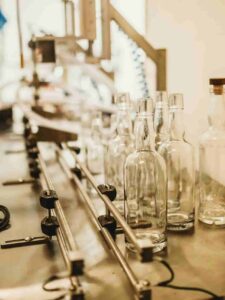Glass bottles are ubiquitous in our daily lives, serving a multitude of purposes from packaging beverages to storing cosmetics and pharmaceuticals. These versatile containers are cherished for their durability, aesthetic appeal, and ability to preserve the purity of their contents. But have you ever wondered what glass bottles are made of and how they are manufactured? The process of creating glass bottles is a remarkable blend of art and science, involving the careful selection of raw materials and precise control of temperatures. This article delves into the fascinating journey of glass making, exploring the essential materials like silica, soda ash, and limestone, and the meticulous steps involved in transforming these raw ingredients into the sleek, empty glass bottles we encounter daily. From the initial mixing of the batch to the final inspection and decoration, each phase of production plays a crucial role in ensuring the quality and functionality of the finished product. Join us as we uncover the intricate process behind the creation of glass bottles and appreciate the expertise of glass makers and manufacturers in bringing these everyday essentials to life.
Section 1 The Basics of Glass Making
1.1 What Are Glass Bottles Made Of?
Glass bottles are primarily made from three key ingredients:
○ Silica (Sand): Silica is the main component of glass, providing the structural framework.
○ Soda Ash (Sodium Carbonate): Soda ash reduces the melting point of silica, making it easier to work with.
○ Limestone (Calcium Carbonate): Limestone adds durability and stability to the glass, preventing it from dissolving in water.
In addition to these primary materials, various additives can be used to alter the properties of the glass, such as colorants and refining agents.

1.2 The Role of a Glass Maker
A glass maker is a skilled artisan who combines these raw materials to create glass products. The process involves several steps, each requiring precision and expertise. Glass makers work in glass manufacturing facilities equipped with furnaces and other specialized equipment to produce high-quality glass bottles.
Section 2 The Glass Making Process
Step 1 – Mixing the Raw Materials
The first step in glass making is mixing the raw materials in precise proportions. This mixture, known as batch, typically consists of 70-75% silica, 12-15% soda ash, and 8-10% limestone, along with small amounts of other ingredients to modify the properties of the final product.
Step 2 – Melting the Batch
The batch is then fed into a furnace, where it is heated to temperatures ranging from 1,400 to 1,600 degrees Celsius (2,550 to 2,910 degrees Fahrenheit). At these high temperatures, the raw materials melt and fuse together to form molten glass.
Step 3 – Forming the Glass Bottles
The molten glass is then shaped into bottles through one of several methods:
○ Blow and Blow Method
In this method, a gob of molten glass is dropped into a mold and air is blown into it, forming a hollow parison (preliminary shape). The parison is then transferred to a finishing mold, where it is blown again to achieve the final shape of the glass bottle.
○ Press and Blow Method
The press and blow method is used for making wide-mouth containers. Here, the molten glass is pressed into a parison mold using a plunger. The parison is then blown into the final shape in a blow mold.
○ NNPB (Narrow Neck Press and Blow)
This method is similar to the press and blow method but is specifically designed for narrow-neck bottles. It provides better control over the bottle’s wall thickness, resulting in lighter and stronger bottles.
Step 4 – Annealing
After forming, the glass bottles are slowly cooled in an annealing oven (lehr). This process, known as annealing, relieves internal stresses within the glass, preventing it from cracking or shattering.
Step 5 – Inspection and Quality Control
Once annealed, the glass bottles undergo a rigorous inspection process to ensure they meet quality standards. Automated systems check for defects such as cracks, bubbles, and inconsistencies in thickness.
Step 6 – Decoration and Finishing
Finally, the glass bottles may be decorated or finished according to customer specifications. This can include applying labels, printing designs, or adding textures to the glass surface.
Section 3 Glass Bottles Wholesale Market
3.1 The Importance of Glass Manufacturers
Glass manufacturers play a crucial role in the supply chain, producing the empty glass bottles that are then sold wholesale to various industries. These industries include food and beverage, cosmetics, pharmaceuticals, and more. The demand for high-quality glass bottles wholesale is ever-increasing as companies seek sustainable and aesthetically pleasing packaging solutions.
3.2 Benefits of Glass Bottles
○ Sustainability: Glass is 100% recyclable, making it an environmentally friendly choice.
○ Purity: Glass does not interact with its contents, preserving the taste and integrity of the product.
○ Aesthetic Appeal: Glass bottles offer a premium look and feel, enhancing the perceived value of the product.

Conclusion
The process of making glass bottles is a complex and intricate one, involving the careful combination of raw materials, precise control of temperatures, and skilled craftsmanship. From the initial mixing of the batch to the final inspection and decoration, each step is crucial in ensuring the production of high-quality glass bottles. Whether you are a glass manufacturer, a glass maker, or a business looking to purchase glass bottles wholesale, understanding the glass making process can help you appreciate the artistry and technology behind these everyday objects.
If you want to learn more about glass bottle manufacturing or have any specific inquiries, feel free to check our website or contact our technician directly. We’re here to provide you with all the information you need and assist you with any questions you might have.










